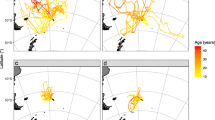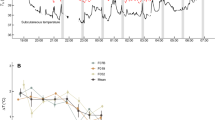Abstract
As predicted by life history theory, once recruited into the breeding population and with increasing age, long-lived animals should be able to manage more efficiently the conflict between self-maintenance and reproduction. Consequently, breeding performances should improve with age before stabilizing at a certain level. Using temperature–depth recorders and isotopic analysis, we tested how age affects the foraging behaviour of king penguin Aptenodytes patagonicus during one trip in the chick-rearing phase. Depending on sex and age, king penguins expressed two different foraging strategies. Older birds gained more daily mass per unit body mass than younger ones. Older females conducted shorter trips, dived deeper and performed more prey pursuits. They also had higher blood levels of δ15N than younger individuals and males indicating sex- and age-specific dietary regimes. However, we found no differences in carbon isotopic signature, suggesting that individuals exploited the same foraging areas independently of sex and age. Our results suggest that king penguins are able to increase the quantity of energy extracted with increasing age and that such a strategy is sex-related. Our study is the first to reveal of an interaction between age and sex in determining foraging efficiency in king penguins.





Similar content being viewed by others
References
Angelier F, Bost C-A, Gireaudeau M, Bouteloup G, Dano S, Chastel O (2008) Corticosterone and foraging behavior in a diving seabird: the Adélie penguin, Pygoscelis adeliae. Gen Comp Endocr 156:134–144
Awkerman JA, Hobson KA, Anderson DJ (2007) Isotopic (δ15N and δ13C) evidence for intersexual foraging differences and temporal variation in habitat use in waved albatrosses. Can J Zool 85:273–279
Bannasch R, Wilson RP, Culik B (1994) Hydrodynamic aspects of design and attachment of a back-mounted device in penguins. J Exp Biol 194:83–96
Barrat A (1976) Quelques aspects de la biologie et de l’écologie du manchot royal Aptenodytes patagonicus des Iles Crozet. Comité National Français des Recherches Antarctiques 40:107–147
Bearhop S, Waldron S, Votier SC, Furness RW (2002) Factors that influence assimilation rates and fractionation of nitrogen and carbon stable isotopes in avian blood and feathers. Physiol Biochem Zool 75:451–458
Bost C-A, Georges J-Y, Guinet C, Cherel Y, Putz K, Charrassin J-B, Handrich Y, Zorn T, Large J, LeMaho Y (1997) Foraging habitat and food intake of satellite-tacked king penguins during the austral summer at Crozet Archipelago. MEPS 150:21–33
Bost C-A, Handrich Y, Butler P, Falhman A, Halsey LG, Woakes AJ, Ropert-Coudert Y (2007) Changes in dive profiles as an indicator of feeding success in king and Adélie penguins. Deep-Sea Res II 54:248–255
Brandt CA (1984) Age and hunting success in the brown pelican—influences of skill and patch choice on foraging efficiency. Oecologia 62(1):132–137
Burnham KP, Anderson DR (1998) Model selection and inference: a practical–theoric approach. Springer, New York
Burnham KP, Anderson DR (2002) Model selection and multimodel inference: a practical information-theoretic approach. Springer, New York
Charrassin JB, Bost C-A (2001) Utilisation of the oceanic habitat by king penguins over the annual cycle. MEPS 221:285–297
Charrassin JB, Bost C-A, Pütz K, Lage J, Dahier T, Zorn T, Le Maho Y (1998) Foraging strategies of incubating and brooding king penguin, Aptenodytes patagonicus. Oecologia 114:194–201
Charrassin JB, Le Maho Y, Bost C-A (2002) Seasonal changes in the diving parameters of king penguins (Aptenodytes patagonicus). Mar Biol 141:581–589
Cherel Y, Ridoux V (1992) Prey species and nutritive value of food fed during summer to king penguin Aptenodytes patagonica chicks at Possession Island, Crozet Archipelago. Ibis 134:118–127
Cherel Y, Hobson KA, Bailleul F, Groscolas R (2005) Nutrition, physiology and stable isotopes: new information from fasting and molting penguins. Ecology 86:2881–2888
Cherel Y, Fontaine C, Richard P, Labat J-P (2010) Isotopic niches and trophic levels of myctophid fishes and their predator in the Southern Ocean. Limnol Oceanogr 55:324–332
Clarke J, Kerry K (1998) Implanted transponders in penguins: implantation, reliability, and long term effects. J Field Ornithol 69:149–159
Cottin M, Kato A, Thierry A-M, Le Maho Y, Raclot T, Ropert-Coudert Y (2011) Does corticosterone affect diving behavior of male Adélie penguins? A preliminary experimental study. Ornithol Sc 10:1–9
Daunt F, Wanless S, Harris MP, Money L, Monaghan P (2007) Older and wiser: improvements in breeding success are linked to better performance in European shags. Funct Ecol 21:561–567
DeForest LN, Gaston AJ (1996) The effect of age on timing of breeding and reproductive success in the thick-billed murre. Ecol 77(5):1501–1511
Descamps S, Gauthier-Clerc M, Gendner J-P, Le Maho Y (2002) The annual breeding cycle of unbanded king penguins Aptenodytes patagonicus on Possession Island (Crozet). Avian Sci 2:87–98
Forero MG, Hobson KA, Bortolotti GR, Donazar JA, Bertellotti M, Blanco G (2002) Food resource utilisation by the Magellanic penguin evaluated through stable-isotope analysis: segregation by sex and age and influence on offspring quality. MEPS 234:289–299
Forero MG, González-Solís J, Hobson KA, Doncazar JA, Bertellotti M, Blanco G, Bortolotti GR (2005) Stable isotopes reveal trophic segregation by sex and age in the southern giant petrel in two different food webs. MEPS 296:107–113
Forslund P, Pärt T (1995) Age and reproduction in birds-hypotheses and tests. Tree 10:374–378
Froget G, Gauthier-Clerc M, Le Maho Y, Handrich Y (1998) Is penguin banding harmless? Polar Biol 20:406–413
Gentry RL, Kooyman GL (1986) Methods of dive analysis. In: Gentry RL, Kooyman GL (eds) Fur seals: maternal strategies on land and at sea. Princeton University Press, New Jersey, pp 28–40
González-Solís J, Croxall P, Wood AG (2000) Sexual dimorphism and sexual segregation in foraging strategies of northern giant petrels Macronectes halli during incubation. Oikos 90:390–398
Goutte A, Antoine E, Weimerskirch H, Chastel O (2010) Age and the timing of breeding in a long-lived bird: a role for stress hormones? Func Ecol 24:1007–1016
Griffiths R, Double MC, Orr K, Dawson RJG (1998) A DNA test to sex most birds. Mol Ecol 7:1071–1075
Hanuise N, Bost C-A, Huin W, Auber A, Halsey LG, Handrich Y (2010) Measuring foraging activity in a deep-diving bird: comparing wiggles, oesophageal temperatures and beak-opening angles as proxies of feeding. J Exp Biol 213:3874–3880
Hobson KA, Clark RG (1993) Turnover of 13C in cellular and plasma fractions of blood: implications for nondestructive sampling in avian dietary studies. Auk 110:638–641
Hobson KA, Gibbs HL, Gloutney ML (1997) Preservation of blood and tissue samples for stable-carbon and stable nitrogen analysis. Can J Zool 75:1720–1723
Kato A, Watanuki Y, Shaughnessy P, Le Maho Y, Naito Y (1999) Intersexual differences in the diving behaviour of foraging subantarctic cormorant (Phalacrocorax albiventer) and Japanese cormorant (P. filamentosus). Comptes rendu de l’Académie des Sciences Serie III Sciences de la Vie Life Sci 322:557–562
Kato A, Watanuki Y, Nishiumi I, Kuroki M, Shaughnessy P, Naito Y (2000) Variation in foraging and parental behavior of King Cormorants. Auk 117:718–730
Kato A, Ropert-Coudert Y, Gremillet D, Cannell B (2006) Locomotion and foraging strategy in foot-propelled and wing-propelled shallow-diving seabirds. MEPS 308:293–301
Kooyman GL, Cherel Y, Lemaho Y, Croxall JP, Thorson PH, Ridoux V (1992) Diving behavior and energetics during foraging cycles in king penguins. Ecol Monogr 62:143–163
Koubbi P, Duhamel G, Herbert C (2001) Seasonal relative abundance of fish larvae inshore at îles Kerguelen, Southern Ocean. Ant Sci 13:385–392
Lack DL (1954) The natural regulation of animal numbers. Clarendon Press, Oxford
Le Vaillant M, Wilson RP, Kato A, Saraux C, Hanuise H, Prud’Homme O, Le Maho Y, Le Bohec C, Ropert-Coudert Y (2012) King penguins adjust their diving behaviour with age. J Exp Biol 215:3685–3692
Lecomte VJ, Sorci G, Cornet S, Jaeger A, Faivre B, Arnoux E, Gaillard M, Trouvé C, Besson D, Chastel O, Weimerskirch H (2010) Patterns of aging in the long-lived wandering albatross. PNAS 107:6370–6375
Lewis S, Schreiber EA, Daunt F, Schenk GA, Orr K, Adams A, Wanless S, Hamer KC (2005) Sex-specific foraging behavior in tropical boobies: does size matter? Ibis 150:408–414
Marchetti K, Price T (1989) Differences in the foraging of juvenile and adult birds: the importance of developmental constraints. Biol Rev 64:51–70
Nisbet ICT, Dann P (2009) Reproductive performance of little penguins Eudyptula minor in relation to year, age, pair-bond duration, breeding date and individual quality. J Avian Biol 40:296–308
Pärt T (1995) Does breeding experience explain increased reproductive success with age? Proc R Soc B 360:113–117
Pärt T (2001) The effects of territory quality on age-dependent reproductive performance in the northern wheatear, Oenanthe oenanthe. Anim Behav 62:379–388
Pinet P, Jaquemet S, Phillips RA, Le Corre M (2012) Sex-specific foraging strategies throughout the breeding season in a tropical, sexually monorphic small petrel. Anim Behav 83:979–989
Pinheiro J, Bates D, DebRoy S, Sarkar D, Team TRDC (2010) nlme: linear and nonlinear mixed effect models. R package version 3.1-102
Pütz K, Cherel Y (2005) The diving behaviour of brooding king penguins (Aptenodytes patagonicus) from the Falkland Islands: variation in dive profiles and synchronous underwater swimming provide new insights into their foraging strategies. Mar Biol 147:281–290
R Development Core Team (2008) R: a language and environment for statistical computing [Internet]. Vienna (Austria): R Foundation for Statistical Computing. Available from: http://www.R-project.org
Ridoux V (1994) The diets and dietary segregation of seabirds at the subantarctic Crozet Islands. Mar Ornithol 22:1–192
Rütz C, Whittingham MJ, Newton I (2006) Age-dependent diet choice in an avian top predator. Proc R Soc B 273:579–586
Saraux C, Chiaradia A, Le Maho Y, Ropert-Coudert Y (2011) Everybody needs somebody: unequal parental effort in little penguins. Behav Ecol 22:837–845
Schreer JF, Kovacs KM (1997) Allometry of diving capacity in air-breathing vertebrates. Can J Zool 75:339–358
Schulte-Hostedde AI, Zinner B, Millar JS, Hickling GJ (2005) Restitution of mass-size residuals: validating body condition indices. Ecology 86:155–163
Weimerskirch H, Stahl JC, Jouventin P (1992) The breeding biology and population-dynamics of king penguins Aptenodytes patagonica on the Crozet-Islands. Ibis 134:107–117
Weimerskirch H, Cherel Y, Cuenot-Chaillet F, Ridoux V (1997) Alternative foraging strategies and resource allocation by male and female wandering albatross. Ecology 78:2051–2063
Welcker J, Steen H, Harding AMA, Gabrielsen GW (2009) Sex-specific provisioning behaviour in a monorphic seabirb with a biomodal foraging strategy. Ibis 151:502–513
Wilson RP (1995) A device for measuring seabird activity at sea. J Avian Biol 26:172–175
Wilson RP, Wilson MPT (1989) Tape—a package-attachment technique for penguins. Wildl Soc Bull 17:77–79
Wilson RP, Cooper J, Plötz J (1992) Can we determine when marine endotherms feed? A case study seabirds. J Exp Biol 167:267–275
Zimmer I, Ropert-Coudert Y, Kato A, Ancel A, Chiaradia A (2011) Does foraging performances change with age in female little penguins (Eudyptula minor). PLoSOne 6:e16098
Acknowledgments
Thanks to Paul E. Viblanc for his help in pre-analysing diving data. We are grateful to B. Friess for his help on the Radio Frequency IDentification analysis and H. Gachot-Neveu for sexing birds. Thanks to T. Raclot for his help in delipidating samples, to J.-P. Robin for lyophylizing samples and to P. Richard and G. Guillou for isotopic measurements. We thank all volunteers for their help with field work. This work was supported by the Institut Polaire Français Paul-Emile Victor (Program ECOPHY 137), and by the grants from the Centre National de la Recherche Scientifique, the Fondation Prince Albert II de Monaco (http://www.fpa2.com) and the Fondation des Treilles (to M.L.V.), and the Marie Curie Intra European Fellowship (FP7-PEOPLE-IEF-2008, European Commission; project No 235962) (to C.L.B.).
Ethical note
All procedures employed during animal handling, PIT-tag implantations and data-logger deployments were approved by the Ethical Committee of the French Polar Institute (IPEV Program ECOPHY 137: permits 01/315/AUT issued on the 4 July 2001, 01/322/AUT issued on the 16 August 2001, 2005-191 issued on the 21 November, 2009-57 issued on the 26 August, and 2009-59 issued on the August 29). The handling of individuals was performed without anaesthetic and lasted no longer than 15 min.
Author information
Authors and Affiliations
Corresponding author
Additional information
Communicated by S. Garthe.
Electronic supplementary material
Below is the link to the electronic supplementary material.
Rights and permissions
About this article
Cite this article
Le Vaillant, M., Le Bohec, C., Prud’Homme, O. et al. How age and sex drive the foraging behaviour in the king penguin. Mar Biol 160, 1147–1156 (2013). https://doi.org/10.1007/s00227-013-2167-y
Received:
Accepted:
Published:
Issue Date:
DOI: https://doi.org/10.1007/s00227-013-2167-y




